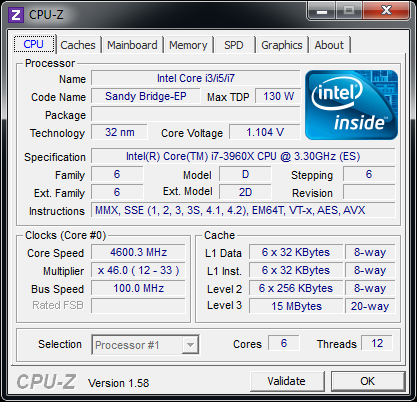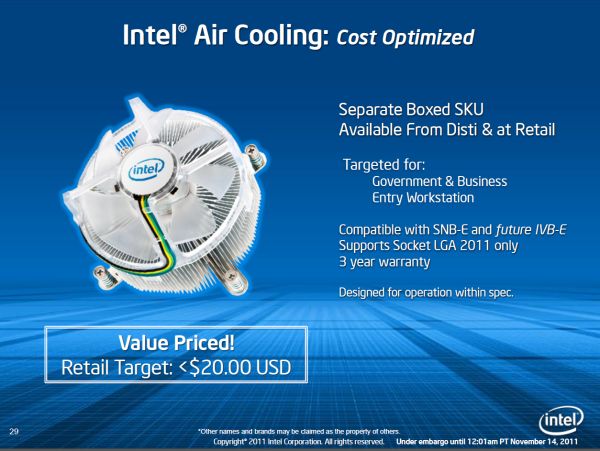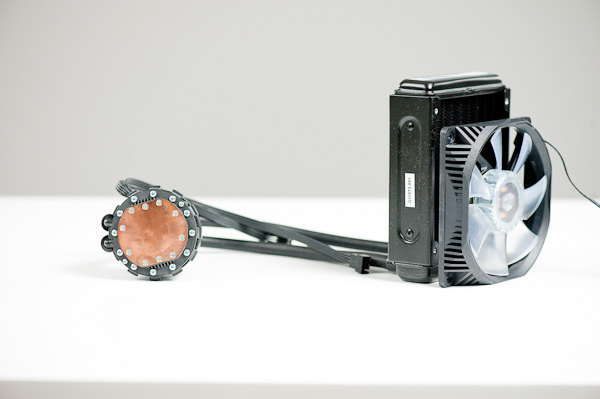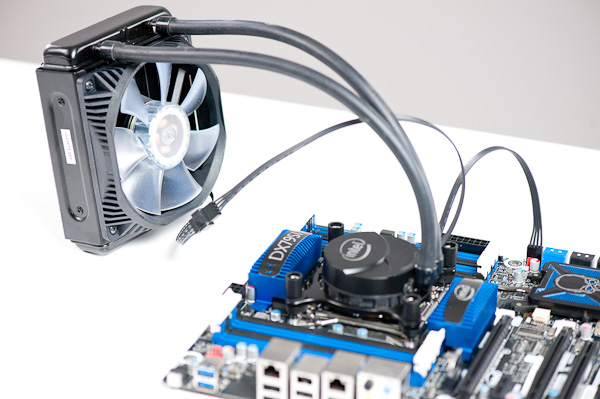Intel Core i7 3960X (Sandy Bridge E) Review: Keeping the High End Alive
by Anand Lal Shimpi on November 14, 2011 3:01 AM EST- Posted in
- CPUs
- Intel
- Core i7
- Sandy Bridge
- Sandy Bridge E
Overclocking
Sandy Bridge brought the motherboard's clock generator onto the 6-series chipset die. In doing so, Intel also locked its operation to 100MHz. While there was a bit of wiggle room, when combined with a locked processor, Intel effectively killed overclocking with most lower end Sandy Bridge chips.
For its more expensive CPUs, Intel offered either partially or fully unlocked (K-series) CPUs. The bus clock was still fixed at 100MHz, but you could overclock your processor by increasing its clock multiplier just like you could in the early days of overclocking.
With Sandy Bridge E, overclocking changes a bit. The clock generator is still mostly impervious to significant bus clock changes, however you're now able to send a multiple of its frequency to the CPU if you so desire. The options available are 100MHz, 125MHz, 166MHz and 250MHz.
Once again, wiggle room at any of these frequencies is limited so don't think we've moved back to the days of bus overclocking. You do get a little more flexibility, particularly with partially unlocked CPUs, but otherwise SNB-E overclocking is hardly any different from its predecessor.
Note that even if you select any of these options, the rest of the system still operates within spec. The multiplied bus clock is only fed to the CPU.

With a bit of effort I had no problems hitting 4.6GHz on my Core i7 3960X review sample. I had to increase core voltage from 1.104V to 1.44V, but the system was stable. While I could get into Windows at 4.8GHz and run a few benchmarks, the system wasn't completely stable.
No Cooler Included
None of the retail or OEM SNB-E parts include an Intel cooler in the bundle, a significant departure from previous CPUs. Presumably the cost of bundling a beefy cooler with these parts would've driven prices higher than Intel would've liked (remember you are getting a much larger die for roughly the same price as the outgoing Core i7 990X). Intel can also rationalize its decision against including any sort of cooler in the retail box by looking at the fact that many enthusiasts at this level opt for aftermarket cooling regardless.
Intel hasn't completely left SNB-E cooling up to 3rd party vendors however. There are two official Intel coolers available for use with SNB-E. The first is a < $20 heatsink that looks a lot like Intel's current coolers but with a couple of modifications (clear fan/shroud, retention screws instead of pegs). Intel states that this cooler is designed for operation within spec, meaning it could possibly limit overclocking attempts.

If you want an Intel branded overclocking solution, there's the RTS2011LC:

This is a closed loop liquid cooling solution similar to what AMD introduced alongside its Bulldozer CPU and similar to what many 3rd party cooling companies already offer. Intel expects its liquid cooling solution to be priced somewhere in the $85 - $100 range.
These closed loop liquid coolers are great primarily for getting away from the tower-of-metal heatsinks that have grown in popularity over the past several years. The radiator is a too small to compete with more traditional water cooling systems, but it can be a good gateway drug for the risk averse.











163 Comments
View All Comments
xpclient - Monday, November 14, 2011 - link
I read Intel is not going to release AHCI/SATA/Matrix RAID drivers for 32-bit Windows XP for X79. Why??? Without AHCI, performance is going not going to be optimal. For those that dual boot with Windows 7, this means changing the settings from AHCI to IDE every time you boot into XP.Rick83 - Monday, November 14, 2011 - link
And I heard that USB 3 had no drivers for my Win95 D either!B3an - Monday, November 14, 2011 - link
Because no one in there right mind would buy this high-end platform then use a decade old POS operating system. Waste of Intels time to support it and XP needs to die already.XP will take little advantage of SSD's or even new HDD's properly, some drives wont even work at all on it, and it lacks the same level of support and performance for CPU features and multiple cores that Win7 has. If you really need to run some old software just use XP mode in Win 7 or use VM software.
xpclient - Monday, November 14, 2011 - link
Are you not aware of multi-core benchmarks? http://www.infoworld.com/t/platforms/generation-ga... Windows 7 does not perform faster than XP until you reach eight cores or higher.Peskarik - Monday, November 14, 2011 - link
"Just as with previous architectures, installing fewer DIMMs is possible, it simply reduces the peak available memory bandwidth."So, I have:
Asus P8Z68-V Pro/Gen3 motherboard
Intel Core i7 2600K
Corsair Vengeance Red, 2x4GB, DDR3-1600, CL9@1.5V
When I am in BIOS the memory is set to 1333Mhz, and I had to manually set it to 1600, though I am not sure whether it actually runs at this speed (how can I check?).
Does the above sentence from the article mean that with 8GB RAM I do not have full memory bandwidth and that if I install 16GB RAM (I have 4 slots) then I have full 1600Mhz automatically?
kr1s69 - Monday, November 14, 2011 - link
Sandy Bridge E is quad channel and so needs 4 DIMM's to obtain the peak bandwidth. Your Sandy Bridge system is dual channel and so you need 2 DIMM's to obtain the peak bandwidth. This is what you currently have installed, so no need to worry.The statement you quoted is basically saying this motherboard would boot with less than 4 DIMM's installed, that is all.
Sandy Bridge defaults to 1333Mhz but you can change this in the BIOS to 1600Mhz as you have done. You can download CPU-Z to confirm what speed your RAM is set to.
piroroadkill - Monday, November 14, 2011 - link
Set the O/C Profile to X.M.P.This uses the eXtreme Memory Profile provided by your RAM. Basically, standard SPD ratings don't go as high as 1600. XMP is required for this, it's a custom Intel extension to SPD.
piroroadkill - Monday, November 14, 2011 - link
Although it's supposed to work, in my experience I had to set my RAM to DDR3-1600 anyway. Ho hum.lukarak - Monday, November 14, 2011 - link
This is not a great update. I wonder if 2011 will be the socket for ivy bridge E. If that's the case, it could be a good buy for somebody transitioning from an older system.dlitem - Monday, November 14, 2011 - link
There were some rumors / news circulating earlier that VT-d is bugged. Is that actually the case? SB-E is The workstation platform and losing VT-d is kind of a shame, as there actually are people who might have benefited from it.Also, a lot of us are still running our trusty 3 year old Quad-Bloomfields that have served us so well, so including one LGA1366 Quad-core would have be a really nice thing.